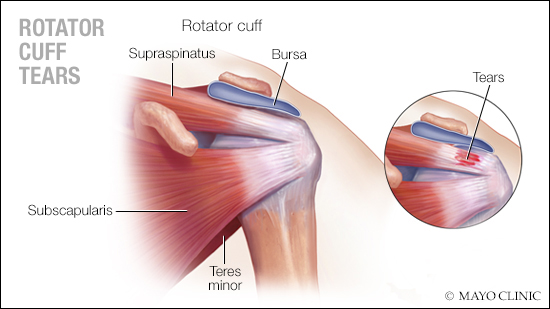
DEAR MAYO CLINIC: I am 48, and I have been playing tennis for years. I also swim regularly. Recently, I have been experiencing pain in my right shoulder every time I hit the court and when I try to lift objects at home. How do I know if I tore my rotator cuff? What are the options for treatment, and can I get back to playing?
ANSWER: People can injure their rotator cuff in several ways. Accordingly, it can be hard to know if that is the primary source of your shoulder problems. For some people, a distinct injury or accident results in a rotator cuff tear. For others, it could be a slow, gradual increase in pain over time. For those with distinct injuries, these usually occur when trying to lift heavy objects overhead or lifting things away from the body. You also can injure your rotator cuff during traumatic falls or accidents.
Generally speaking, rotator cuff problems tend to produce three main symptoms: shoulder pain, decreased shoulder motion and weakness. Although most patients will have some level of each of these symptoms, not everyone with a rotator cuff tear will have all three symptoms.
In terms of the pain, if you have a rotator cuff injury, you typically have pain over the lateral, or outside, portion of the shoulder, around the deltoid muscle. This pain generally worsens when you try to lift your arm overhead or lift objects away from your body.
Other injuries around the shoulder can result in similar symptoms. Some of the more common injuries are biceps tendinitis, acromioclavicular joint injuries or arthritis. Patients with biceps tendinitis tend to have pain in the front of the shoulder, and those with acromioclavicular joint injuries tend to have pain on top of the shoulder.
Understanding where your pain is originating from can help differentiate these problems from pain caused by your rotator cuff. If you have pain on the lateral, or outside, part of your shoulder with decreased range of motion and difficulty lifting objects, you may have a rotator cuff injury. Oftentimes, this can be some mild tendinitis that will improve with a few days of rest. However, if your symptoms are severe or they persist for more than one or two weeks, it makes sense to talk to your health care provider. He or she can typically diagnose a rotator cuff tear based on your symptoms, a physical exam, and potentially imaging, such as X-rays and an MRI.
When I diagnose a patient with a rotator cuff injury, the most common question I get is whether surgery is necessary. If you have been diagnosed with a rotator cuff injury, treatment may vary depending on the severity.
For most patients with tendinitis, which is inflammation of the rotator cuff tendon without a complete tear, as well as pain and other symptoms, they generally improve without surgical intervention. The most common forms of treatments for this are anti-inflammatory medications; icing the shoulder regularly; modifying your activities, including avoiding heavy lifting and overhead lifting; and physical therapy.
For patients with complete tears of the tendon, the situation is a little bit more complex. If the tear is small or the patient is relatively low risk, some patients with complete tears may still be able to avoid surgery. The treatment plan for them would be the same options listed for tendinitis above. Although physical therapy won't heal the small tears, it can help optimize the other muscles around the shoulder that are still intact, which allows them to compensate for the tendon that has the small tear in it.
For active patients with a complete tear of the tendon, surgery may be optimal because it offers the most predictable and successful way of restoring function.
Rotator cuff repair surgery typically is done as an outpatient procedure through a minimally invasive, or arthroscopic, approach. Using these small incisions can reduce pain and improve recovery long term.
After undergoing rotator cuff repair, the arm is kept in a sling for approximately six weeks after surgery to allow things to heal. After this time, the sling is slowly discontinued, and formal physical therapy is initiated. The early focus of physical therapy is on restoring range of motion. This typically takes three or four months from the date of surgery. Around two or three months after surgery, gentle strengthening exercises are introduced. Then patients will progress to additional rehabilitation.
While there is significant variability, the average overall recovery time following rotator cuff repair is approximately six months. Once everything is healed, we generally allow patients to get back to all activities as tolerated. However, it is a good idea to avoid any unnecessary overhead lifting over the long term. This reduces the risk of having recurrent problems and injuries down the road. — Dr. Christopher Camp, Orthopedic Surgery, Mayo Clinic, Rochester, Minnesota
****************************
Related Articles
- Mayo Clinic Q and A: Rotator cuff tears — treatment and recovery published 9/25/20
- Mayo Clinic Minute: When should you have rotator cuff surgery? published 9/3/19
Related Articles







